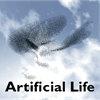Guideless Artificial Life Model for Reproduction, Development, and Interactions
IF 1.5
4区 计算机科学
Q4 COMPUTER SCIENCE, ARTIFICIAL INTELLIGENCE
引用次数: 0
Abstract
Reproduction, development, and individual interactions are vital yet complex natural processes. Tierra (an ALife model proposed by Thomas Ray) and cellular automata, which can manage these aspects in a complex manner, are significantly limited in their ability to express morphology and behavior. In contrast, the virtual creatures proposed by Karl Sims have a considerably higher degree of freedom in terms of morphology and behavior. However, they also exhibit a limited capacity for processes like reproduction, development, and individual interactions. In addition, they employ genetic algorithms, which can result in a loss of biological diversity, as their implementation necessitates predefining a fitness function. Contrarily, the evolution of natural life is determined by mutation and natural selection, rather than by a human-defined fitness function. This study carefully extracts the characteristics of these models to propose a new Artificial Life model that can simulate reproduction, development, and individual interactions while exhibiting a high expressive power for morphology and behavior. The model is based on the concept of incorporating Tierra and cellular automata mechanisms into a cell that moves freely in 3-D space. In this model, no predefined fitness function or form that qualifies as a living creature exists. In other words, this approach can be rephrased as searching for persistent patterns, which is similar to the approach of Conway’s Game of Life. The primary objective of this study was to conduct a proof-of-concept demonstration to showcase the capabilities of this model. Guideless simulation by the proposed model using mutation and natural selection resulted in the formation of two types of creatures—dumbbell shaped and reticulated. These creatures exhibit intriguing features, exploiting the degrees of freedom inherent to the proposed model. Particularly noteworthy is their unique method of reproduction, which bears a striking resemblance to that of real organisms. These results reinforce the potential of this approach in modeling intricate processes observed in actual organisms and its ability to generate virtual creatures with intriguing ecologies.繁殖、发展和相互作用的无导向人工生命模型。
繁殖、发育和个体相互作用是重要而复杂的自然过程。Tierra (Thomas Ray提出的一种ALife模型)和元胞自动机能够以复杂的方式管理这些方面,但它们在表达形态和行为方面的能力明显有限。相比之下,卡尔·西姆斯提出的虚拟生物在形态和行为方面具有相当高的自由度。然而,它们在繁殖、发育和个体互动等过程中也表现出有限的能力。此外,它们采用遗传算法,这可能导致生物多样性的丧失,因为它们的实现需要预先定义适应度函数。相反,自然生命的进化是由突变和自然选择决定的,而不是由人类定义的适应度函数决定的。本研究仔细提取了这些模型的特征,提出了一个新的人工生命模型,可以模拟繁殖,发育和个体互动,同时表现出对形态和行为的高表达能力。该模型基于将Tierra和细胞自动机机制结合到一个在三维空间中自由移动的细胞中的概念。在这个模型中,不存在预定义的适合度函数或符合生物条件的形式。换句话说,这种方法可以被重新表述为寻找持久模式,这与康威的生命游戏的方法类似。本研究的主要目标是进行概念验证演示,以展示该模型的功能。该模型利用突变和自然选择进行无导向模拟,形成了哑铃形和网状两种类型的生物。这些生物表现出有趣的特征,利用了所提出模型固有的自由度。特别值得注意的是它们独特的繁殖方式,与真正的生物体惊人地相似。这些结果加强了这种方法在模拟实际生物体中观察到的复杂过程方面的潜力,以及它产生具有有趣生态的虚拟生物的能力。
本文章由计算机程序翻译,如有差异,请以英文原文为准。
求助全文
约1分钟内获得全文
求助全文
来源期刊

Artificial Life
工程技术-计算机:理论方法
CiteScore
4.70
自引率
7.70%
发文量
38
审稿时长
>12 weeks
期刊介绍:
Artificial Life, launched in the fall of 1993, has become the unifying forum for the exchange of scientific information on the study of artificial systems that exhibit the behavioral characteristics of natural living systems, through the synthesis or simulation using computational (software), robotic (hardware), and/or physicochemical (wetware) means. Each issue features cutting-edge research on artificial life that advances the state-of-the-art of our knowledge about various aspects of living systems such as:
Artificial chemistry and the origins of life
Self-assembly, growth, and development
Self-replication and self-repair
Systems and synthetic biology
Perception, cognition, and behavior
Embodiment and enactivism
Collective behaviors of swarms
Evolutionary and ecological dynamics
Open-endedness and creativity
Social organization and cultural evolution
Societal and technological implications
Philosophy and aesthetics
Applications to biology, medicine, business, education, or entertainment.
 求助内容:
求助内容: 应助结果提醒方式:
应助结果提醒方式:


